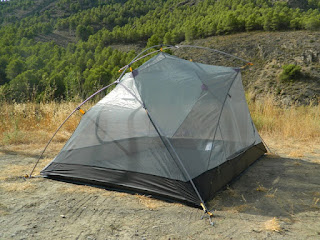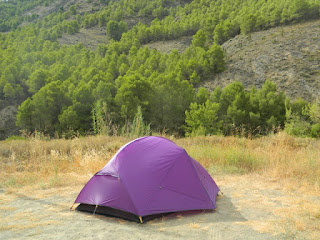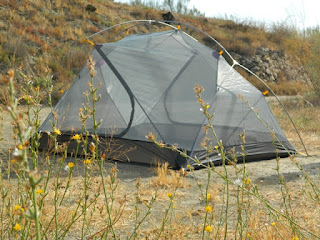After a recent camping trip in 30 degree heat and 90% humidity that was so ghastly that we had to abandon it two days in, I decided what I needed was an inner-pitch-first tent. While a lot of people don't like this design due to the fact that it isn't ideal for pitching in the rain, certain implementations of this design allow for leaving the flysheet off, and that's exactly what I wanted.
It didn't take much investigation before I came across the Naturehike Mongar 2, a free-standing inner-pitch-first tent that also ticked a lot of other boxes.
As always, the first thing I did when my Mongar 2 arrived was get it on the weighing scales. Naturehike advertise its weight at 2.2kg all-in, including the supplied footprint (yes, the footprint comes included - other manufacturer's take note!). My scales said 2.157kg, so we were off to a good start.
While my current go-to hiking tent - the Wild Country Zephyros 2 - weighs in at 1.854kg, I'd surprisingly never weighed it together with the footprint, and here's where things start to get interesting; excluding pegs, the Zephyros 2 and footprint have a combined weight of 2.209kg. Remove the pegs from the Mongar 2, and the total weight is 2.031kg! Despite being much larger, the Mongar 2 is the lighter tent.
Pitching is ridiculously quick and easy - on my first time pitch, I single-handedly had it up in a fraction over 4 minutes - the fastest pitch I think I've ever achieved. Naturehike quote 5 minutes for a first-time pitch, though to be fair I didn't peg out the guylines so this is probably about right. Though instructions are included in the bag they are unnecessary. Simply peg out the four corners of the footprint, pop the ends of the double-Y-frame poles into the footprint eyelets, then clip the inner to the poles. The inner also has pole eyelets at the corners, which you can then pop the poles back through, and this also allows for pitching without the footprint. The fly then gets draped over the poles and clipped via a simple buckle system to tapes at the corners of the inner. If not using the guylines, pitching is completed by pegging out the front and back of the fly and the two doorways.
Though billed as an inner-pitch-first tent, attaching the poles to the groundsheet first means you can actually put the fly over the poles before suspending the inner (albeit with a bit of contortionism), but of course you do have to do the latter with at least one door of the fly open, so if pitching in inclement weather the inner could still get wet. It does however give you the option to pitch without the inner if you just need to get some quick shelter from the rain.
 |
| The free-standing, double-Y-frame design allows the tent to be pitched inner-only - great for some stargazing! |
The Mongar 2 has an internal footprint of 210 x 135cm - for reference, that's the same width as a standard UK-spec double bed, so it's a comfortable size for two people. 210cm seems to be a common internal length for tents, and as I stand at 6'3" (190cm) it should be ample, however the several tents I've been in and/or owned at this length have generally seemed cramped, and I've usually found I've had to put myself on a slight angle to lay out properly because of the way the inner fabric tapers in towards the apex. Not so in this case; the lower end panels of the inner extend upwards more-or-less vertically, so I can comfortably use the full length of the tent. The pole system incorporates a crossbar which serves to hold the side walls in a near-vertical position too, making this the most capacious two person tent I have been in to date - two people can comfortably sit upright at the same time.
The tent boasts two side doors, and the entrances of the fly can either be fully opened or half-opened with toggles provided for holding all door panels (inner and fly) open. Inevitably one half of each fly opening will need pegging down to maintain the tent's shape when closed, but the fact that both sides can be left fully open during the day is a bonus in terms of access and ventilation. Speaking of - there is a vent at each of the tent as well. Once closed, the outer doors form two vestibules for gear storage, though (and this isn't uncommon) the footprint doesn't extend into these areas, so in wet weather your gear will still be sat on the bare ground. If used as a one-person tent however - and given the weight of the tent that's more than viable - there is ample room to get your gear inside with you.
 |
| The Mongar 2 has a symmetrical design with two side doors, and on the flysheet these can be either half opened (as shown) or fully opened. |
Inside the tent there are storage pouches at each end, plus a suspended (and detachable, should you want to shed a bit more weight) ceiling storage "shelf", plus a lamp hook.
In order to keep the weight down, the bulk of the Mongar 2 (groundsheet & flysheet) is constructed of 20D silicone-coated ripstop nylon with a hydrostatic head of 4000mm. All seams are taped and double-stitched, the stitching is consistent and even, and the whole tent has the feel of a quality product. Now it's rare to get rain in our part of Spain at this time of year, but out of nowhere, several hours after pitching up, a storm came over. So for once I can actually testify that it is, as you would expect, waterproof!
 |
| The vents at each end should provide ample ventilation |
20D nylon is of course quite thin (a necessary trade-off if you want to keep weight down while maintaining size/capacity), and while fine for the flysheet it does feel a little on the thin side for the groundsheet, though I don't see this being a problem when used in combination with the footprint. The poles are 7001 aluminium which flex nicely when erecting and don't ever feel like they are being forced into place.
The Mongar 2 has single-handedly replaced two of my other tents; lighter and yet massively more capacious than my current solo hiking tent, the Mongar also packs down smaller and has a more stable design than the former's tunnel shape. Likewise, for my two-person campsite trips, the Mongar's two-door design, bigger internal space thanks to the vertical walls, better waterproofing and considerably less weight and bulk than my existing tent means that has also been relegated to the spares pile.
I literally have nothing negative to say about this tent. Everything about it feels quality. Even the pegs - something which I normally have to replace straight away - are good quality Y-shape alloy pegs with cord loops for easy removal. It includes the footprint, which is a rare thing - normally the footprint is an excuse to squeeze a bit more money out of the customer. All these benefits should come at a cost, but in comparison to other options they don't in fact. Yes, if you were shopping purely for a campsite tent then there are cheaper - but probably not better - options available, but as a one/two-person hiking tent I just don't see how this can be beaten - not for this price and not without spending a considerable amount more.
It isn't just lightweight, it's versatile; free-standing or fully guyed-out; it can be pitched inner only, flysheet only, inner first or, at push, fly first; it's lightweight enough to serve as a spacious one-person hiking tent, and spacious enough to use comfortably as a two-person tent. On top of all that, an additional vestibule is available to expand the tent further, giving additional shelter or gear storage.
While I can only make real-world comparisons to tents I've owned or used, I've done a lot of reading into and comparing other options, and in the sub-£200 price-bracket this should probably be your first choice. It gives many tents in the £200-£300 price-range a run for their money too.



Great review, mate. Thank you for sharing. I’m seriously considering this tent.
ReplyDeleteHow did you manage to pitch with the outer fly alone?
ReplyDeleteMy footprint had no plastic clips to attach the fly to. Which meant that the only way to get the fly up is to attach it to the inner.
Am I doing something wrong?
Hi Kiron, I don't know if they've change the design at some point, but the corner straps of the fly on mine have eyelets on the ends that the pole ends sit into.
DeleteAre the folded poles really 50cm in length? I am looking for a tent that's more like 40cm in packed length/ Thanks
ReplyDeleteThey're more like 40cm, but because they're all joined with the elastic, the junction pieces kind of prevent them all aligning, so the packed length ends up being 45cm.
DeleteDoes different colors have different weights?
ReplyDeleteI don't know I'm afraid, but I did find Naturehike to be quite responsive when I contacted them with some questions previously.
Delete